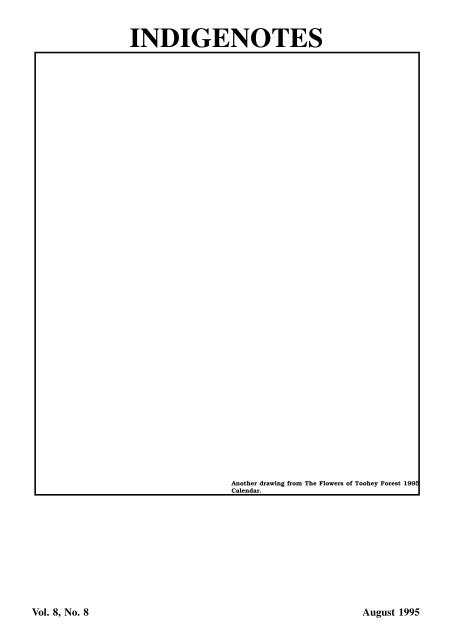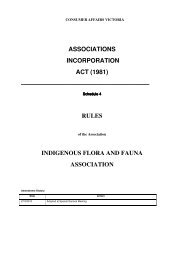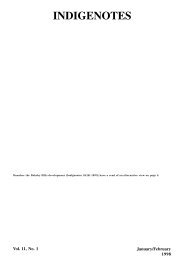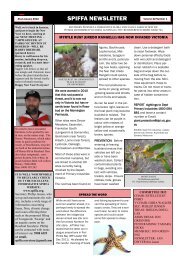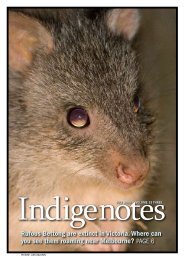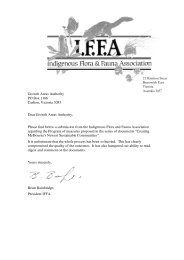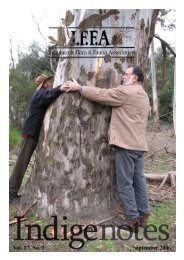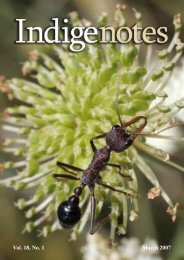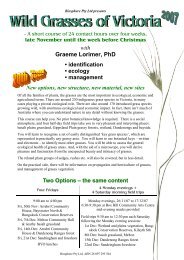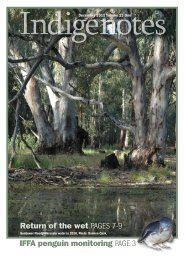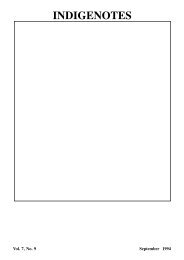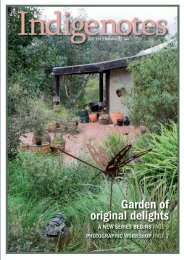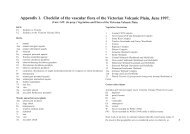8-8 August 1995 - Indigenous Flora and Fauna Association
8-8 August 1995 - Indigenous Flora and Fauna Association
8-8 August 1995 - Indigenous Flora and Fauna Association
Create successful ePaper yourself
Turn your PDF publications into a flip-book with our unique Google optimized e-Paper software.
INDIGENOTES<br />
Another drawing from The Flowers of Toohey Forest <strong>1995</strong><br />
Calendar.<br />
Vol. 8, No. 8 <strong>August</strong> <strong>1995</strong>
Questions from<br />
the Ganges<br />
By Fran Peavey<br />
I'm from Idaho. It doesn't generally occur to a<br />
girl from Idaho to think of playing a part in the<br />
cleaning up of the Ganges River. But a friend<br />
from India, Dr. V.B. Mishra - a hydraulic<br />
engineer <strong>and</strong> a Hindu religious leader - asked me<br />
to help him clean up the river. I had no<br />
experience of cleaning up rivers. I knew nothing<br />
about sewage. What I did know about was how to<br />
build a strategy for social change. That, it<br />
seemed, was what Dr. Mishra <strong>and</strong> his group<br />
needed.<br />
When I went to India, I used strategic questioning<br />
to help people form their own opinions of what<br />
should be done to clean their sacred river. I<br />
began by building a series of questions, starting<br />
with how they saw the problem themselves.<br />
"What do you see when you look at the river?"<br />
"How do you feel about the condition of the<br />
river?" "How do you explain the situation with<br />
the river to your children?" I listened carefully<br />
to how they explained to themselves what they<br />
saw. Essentially I was looking at their logic as<br />
well as their words. I was looking for the cultural<br />
wiring around the river.<br />
I couldn't say: "Oh, I see that the river is<br />
polluted." In the context of India, that would be<br />
like my saying "Your mother is a whore" to a<br />
westerner. It would be a cultural insult, <strong>and</strong> the<br />
Indians would, at best, stop listening. To arrive<br />
with a fixed idea of the situation would create<br />
reaction <strong>and</strong> resistance. So I had to find out how<br />
they explained the pollution to themselves.<br />
Over <strong>and</strong> over I heard something like "the river<br />
is holy, but she is not pure. We are not taking<br />
care of her the way she needs us to". The funny<br />
thing is that, after hearing this reply, I started to<br />
think less in terms of "pollution" <strong>and</strong> more in<br />
terms of "people not taking care of the river".<br />
This was an important change of perspective.<br />
"Pollution" is an abstraction that does not<br />
address the responsibility of the people who are<br />
making the mess. "Pollution" focuses attention<br />
solely on the river. It is almost as if the river is<br />
to blame for being polluted!<br />
People often said "I see the problem but others<br />
don't." This told me a lot about their society's<br />
taboos, <strong>and</strong> about the distance between people -<br />
what they can <strong>and</strong> cannot talk about with each<br />
other. When the subject is the holy Ganges, the<br />
symbolic burden is so great that to say what you<br />
think may seem sacrilegious or crazy to others.<br />
Culture defines what we may say <strong>and</strong> how to say<br />
it. While it is useful to bring gifts from one<br />
culture to another, it is more powerful to find<br />
strategies for change within the culture facing the<br />
change.<br />
I needed first to underst<strong>and</strong> their change views -<br />
how they expected change to happen, what kind<br />
of strategies had their confidence. In India, no<br />
social change can compare to the country's<br />
liberation from British control; this colours their<br />
perception of how change takes place. When I<br />
asked how the change happened, I heard many<br />
strategies for change - satyagraha (passive<br />
resistance), fasting, direct action, pressuring civic<br />
leaders, citizens' assemblies, marches to the<br />
capital - means of working for change that are<br />
embedded in Indian culture. They were willing to<br />
use these strategies now to clean their holy river.<br />
I would then ask, "What would you like to do to<br />
clean the river?" And they would apply their<br />
change views to this specific situation.<br />
One thirteen year old suggested that he <strong>and</strong> his<br />
friends would like to "get some sticks <strong>and</strong> go up<br />
<strong>and</strong> down the river <strong>and</strong> persuade people not to<br />
toilet on the river." I did not evaluate this idea<br />
but passed it on to the Foundation members.<br />
They recognised the seeds of a great idea in the<br />
one the young man offered. Thus the idea of the<br />
home guard was born. For five years, a team (of<br />
adults) equipped with sticks walked the riverfront<br />
or travelled in a boat, through India's most holy<br />
city, Varanasi. Their task was to discourage<br />
citizens from acts disrespectful to the river -<br />
defecating, washing with soap, <strong>and</strong> dumping<br />
animal carcasses into the river. (Before you get<br />
too judgemental about these behaviours: most<br />
people in India do not have bathrooms in their<br />
homes. And it is hard, in a city of over a million,<br />
to find ground in which to bury cows, goats <strong>and</strong><br />
Page 2<br />
<strong>Indigenous</strong> <strong>Flora</strong> <strong>and</strong> <strong>Fauna</strong> <strong>Association</strong> Inc.<br />
P.O. Box 328, Clifton Hill, Victoria 3068
dogs when they die).<br />
People often told me that it was impossible to<br />
clean the river. Rather than obediently assuming<br />
it was impossible, I started to think that maybe it<br />
was going to take quite a long time <strong>and</strong> that I had<br />
better start thinking about the next generation in<br />
my questioning. I was already talking to young<br />
people, but I added a question for the adults:<br />
"How are you preparing your children to clean up<br />
the river?"<br />
Everyone in the Mochan Foundation had been<br />
asked that question. To a person they had said:<br />
"We are doing nothing to prepare the children to<br />
clean the river." But their love of the river, their<br />
love for their children, <strong>and</strong> the void in their<br />
answers to that question could not long coexist in<br />
their minds. The dissonance was too great.<br />
One afternoon when I was taking a shower,<br />
someone came running in <strong>and</strong> said "Peavey,<br />
come right away, we've got a great idea." I<br />
thought, "Gosh, you know, I rarely get<br />
summoned from the shower by a great idea." I<br />
quickly dressed <strong>and</strong> joined the other Foundation<br />
workers. They were enthusiastically discussing a<br />
plan: "We're going to have a poster-painting<br />
contest for all the students in Benares. We'll<br />
hang the winning posters up at a large musical<br />
event. The adults will see what the children see<br />
<strong>and</strong> be embarrassed..."<br />
It was an original idea <strong>and</strong> clearly the idea was<br />
theirs. Everybody in that room had been asked a<br />
question about the preparation of their children<br />
for river-cleaning work. Could that question have<br />
had anything to do with the emergence of the idea<br />
about the poster contest? I believe it did. But I<br />
didn't come up with the poster idea; it was their<br />
idea, <strong>and</strong> so they had enthusiasm around it.<br />
We have had poster contests almost every year<br />
since then. five to eight hundred young people<br />
have regularly gathered on the banks of the<br />
Ganges for poster-making competitions.<br />
work <strong>and</strong> plans with members of the Foundation<br />
<strong>and</strong> the local citizens. In this public forum, the<br />
officials gave their presentations; then citizens<br />
stood at the microphone <strong>and</strong> spoke of their own<br />
ideas <strong>and</strong> asked questions.<br />
People need to come up with their own answers.<br />
Questioning can catalyse this process. A<br />
powerful question grows a life of its own as it<br />
chisels away at a problem. Don't be disappointed<br />
if a great question does not elicit a great answer<br />
right away. A very powerful question, a longlever<br />
question, may not have an answer at the<br />
moment it is asked. It will sit rattling in the mind<br />
for days or weeks as the person works on an<br />
answer. If the seed is planted, the answer will<br />
grow. Questions are alive.<br />
From the Whole Earth Review, No. 86 Summer <strong>1995</strong><br />
For several years running, the Sankat Mochan<br />
Foundation held a citizens' assembly. Officials of<br />
the Ganges Action Plan came to a large<br />
multicoloured tent to discuss the progress of the<br />
Indigenotes Volume 8, Number 8, <strong>1995</strong><br />
Page 3
Sleepy Hollow Wildlife Shelter<br />
Needs Help for Koalas<br />
Dear Editor<br />
My name is Pam Cale <strong>and</strong> I run the Sleepy Hollow<br />
Wildlife Shelter at Tooradin. A Wildlife Shelter<br />
Permit Holder is licensed by the Department of<br />
Conservation <strong>and</strong> Natural Resources to take in<br />
sick, injured <strong>and</strong> orphaned native animals <strong>and</strong><br />
birds for rehabilitation <strong>and</strong> eventual release back<br />
into their natural habitat.<br />
I have operated my Wildlife Shelter for 13 years<br />
<strong>and</strong> take in between 3,000 <strong>and</strong> 4,000 animals,<br />
including birds, a year. This is a voluntary operation<br />
<strong>and</strong> is run from my own home. We receive no<br />
funding or subsidy <strong>and</strong> it costs us approximately<br />
$150 per week to run the shelter.<br />
Some of the regular species we care for are<br />
Feathertail <strong>and</strong> Sugar Gliders, Brushtail <strong>and</strong><br />
Ringtail Possums, Pygmy Possums, bats <strong>and</strong> Flying<br />
Foxes, Wallabies, Kangaroos, Koalas, Wombats,<br />
Echidnas, lizards <strong>and</strong> tortoises. Some less common<br />
species we have cared for include Green Tree<br />
Frogs, Water Dragons, seals <strong>and</strong> snakes. The<br />
birdlife ranges from wrens, robins, parrots, pelicans,<br />
swans, owls through to large birds of prey<br />
such as Peregrine Falcons.<br />
The main reasons for these animals coming in are<br />
dog or cat attacks, road hits <strong>and</strong> loss of habitat.<br />
Disease <strong>and</strong> shooting also take a toll. Often adult<br />
animals do not survive <strong>and</strong> leave us with orphans<br />
to h<strong>and</strong> raise. Some of the animals are only<br />
bruised or concussed <strong>and</strong> only need to be held for<br />
the short term. For more intensive care animals<br />
may need up to six months to be rehabilitated <strong>and</strong><br />
ready for release. Some of the unfurred orphans<br />
may need 18 months of care before they are ready<br />
for release.<br />
to feed every one or two hours around the clock.<br />
The releasing of the animal is as important as the<br />
raising to ensure a good chance of survival. Possums,<br />
gliders <strong>and</strong> bats need to be released in<br />
nesting boxes to simulate hollows; wombats need<br />
to have a burrow; kangaroos need to be released<br />
into a mob <strong>and</strong> birds into flocks etc. Habitat needs<br />
to be correct <strong>and</strong> food plentiful. If this is all done<br />
properly it requires hard work <strong>and</strong> alot of heart<br />
ache at times. The personal rewards come for me<br />
when the released animals can be sighted 6<br />
months later or better still with a Joey in the<br />
pouch. Some times they bring their young back to<br />
show you as if to thank you.<br />
Our house is no longer coping with the amount<br />
<strong>and</strong> different variety of species I take in, in particular<br />
the ever increasing amount of koalas<br />
finding themselves in trouble. Koalas stress easily<br />
<strong>and</strong> need to be kept separate from the other animals.<br />
The baby koalas require intensive care <strong>and</strong><br />
need to be separate from the sick <strong>and</strong> injured<br />
adults.<br />
We are now in a position where we urgently need<br />
to upgrade our facilities to be able to accommodate<br />
these animals. If anyone is able to assist us in our<br />
efforts to set up a koala hospital <strong>and</strong> nursery<br />
donations can be sent to:<br />
Sleepy Hollow Wildlife Shelter<br />
Pam Cale<br />
3 Matthew St.<br />
Tooradin 3980<br />
or ring Mark <strong>and</strong> Lynette on (059) 851122 for<br />
further information.<br />
Pam Cale<br />
All the animals <strong>and</strong> birds need to be given the<br />
correct formula <strong>and</strong> feed. When raising the orphans<br />
they have to be given a special low lactose<br />
formula <strong>and</strong> as they grow it is important to feed<br />
them the food they will be finding when they are<br />
released. Orphaned pouch young (which are all<br />
called Joeys) need to be kept at temperatures <strong>and</strong><br />
conditions which simulate the mothers pouch. We<br />
use heat pads, hot boxes <strong>and</strong> humicribs for this.<br />
They need to be given the attention <strong>and</strong> care they<br />
would get from their mother while they are young,<br />
but when weaning time comes it is important to<br />
dehumanise them as well. Because the unfurred<br />
joeys are attached to the teat we sometimes have<br />
Page 4<br />
<strong>Indigenous</strong> <strong>Flora</strong> <strong>and</strong> <strong>Fauna</strong> <strong>Association</strong> Inc.<br />
P.O. Box 328, Clifton Hill, Victoria 3068
Platypus Pursuits<br />
Do platypus still live in urbanised<br />
sections of the Yarra River <strong>and</strong> its<br />
tributaries?<br />
Last summer, researchers from the Australian Platypus<br />
Conservancy <strong>and</strong> Melbourne Water joined forces with a<br />
dedicated group of wildlife veterinarians <strong>and</strong> community<br />
volunteers to undertake platypus field surveys along a<br />
number of waterways in the lower Yarra catchment. In addition,<br />
information on recent public sightings of platypus near<br />
Melbourne was gathered through the Great Platypus Count,<br />
conducted in association with The Age. The Platypus Count<br />
attracted nearly 100 reports of platypus seen by anglers,<br />
canoeists, birdwatchers, pedestrians <strong>and</strong> bicyclists. The<br />
sightings were concentrated in two areas: the Yarra River<br />
upstream of Lower Templestowe, <strong>and</strong> the Plenty River<br />
upstream of Greensborough. People were particularly likely to<br />
see platypus in the Yarra near Warr<strong>and</strong>yte State Park, where<br />
the animals were observed climbing out of the water onto<br />
logs, floating quietly in midstream, <strong>and</strong> playing in rapids. Few<br />
recent reports were received of the platypus in the inner<br />
suburbs, although animals were possibly spotted on three<br />
occasions last year along the lower reaches of Merri Creek.<br />
Single sightings were also reported along Gardiners Creek <strong>and</strong><br />
the point where Ch<strong>and</strong>ler Highway crosses the Yarra in Kew.<br />
The results of the field surveys confirmed that platypus are<br />
still reasonably abundant in parts of the upper Plenty River<br />
catchment. In addition, the animals were found in the lower<br />
reaches of Watson's Creek (in Kangaroo Ground), Diamond<br />
Creek (in Eltham) <strong>and</strong> - to the surprise of many people - the<br />
lower Plenty River (in Yallambie) <strong>and</strong> Mullum Mullum Creek<br />
(in Doncaster East <strong>and</strong> Templestowe).<br />
Along the Yarra, juvenile platypus were encountered near<br />
Kangaroo Ground <strong>and</strong> Warr<strong>and</strong>yte <strong>and</strong> at the mouth of<br />
Diamond Creek, indicating that the species is breeding<br />
successfully in the river at least as far downstream as<br />
Templestowe.<br />
The Australian Platypus Conservancy plans to continue<br />
undertaking field surveys near Melbourne over the next few<br />
years, both to replicate this year's findings <strong>and</strong> to exp<strong>and</strong> the<br />
geographic scope of the work.<br />
Upcoming Lecture Series<br />
The Australian Platypus Conservancy is presenting a program<br />
of public lectures through <strong>August</strong> <strong>1995</strong>. They will<br />
presented by Dr. Melody Serena, the project's co-ordinator at<br />
a number of venues around Melbourne. For further detalis<br />
contact: (03) 9716 1626.<br />
Why not become a Friend of the Platypus?<br />
The Australian Platypus Conservancy is a non-profit association<br />
<strong>and</strong> depends on the support of individuals, community<br />
groups <strong>and</strong> businesses who share an interest in this amazing<br />
species. For additional information contact (03) 9716 1626<br />
From Ripples, Newsletter of the Australian Platypus<br />
Conservancy<br />
Indigenotes Volume 8, Number 8, <strong>1995</strong><br />
New Publications:<br />
Managing Vertebrate<br />
Pests: Rabbits<br />
A new book on rabbits has been published by the<br />
Bureau of Resource Sciences <strong>and</strong> the CSIRO<br />
Division of Wildlife <strong>and</strong> Ecology. Titled<br />
Managing Vertebrate Pests Rabbits it is one in a<br />
series of of publications dealing with vertebrate<br />
pests. This volume aims to provide l<strong>and</strong><br />
managers with "best practice" national<br />
guidelines for managing the agricultural <strong>and</strong><br />
environmental damage caused by rabbits.<br />
There are six parts to the book covering the<br />
history, distribution <strong>and</strong> biology; impacts <strong>and</strong><br />
use; community attitudes; techniques <strong>and</strong><br />
management; Strategic rabbit management <strong>and</strong><br />
future directions.<br />
On a first glance it looks like being an essential<br />
addition to the library for l<strong>and</strong> managers <strong>and</strong><br />
anyone interested in rabbit management. A copy<br />
will be available at the meeting for people to have<br />
a browse.<br />
Australian Grassl<strong>and</strong>s<br />
This new brochure, produced by the Grassl<strong>and</strong>s<br />
Ecology Program (within the Australian Nature<br />
Conservation Agency) describes the ecological<br />
value <strong>and</strong> current status of these highly<br />
threatened vegetation types in Australia.<br />
Available from the ANCA on 1800 671 717.<br />
The Bushweed Database 2<br />
of Environmental Weeds<br />
in Australia<br />
This publication, compiled by J.T. Swarbrick <strong>and</strong><br />
D.B. Skarratt, brings together the scattered<br />
information on weeds of urban bushl<strong>and</strong>, national<br />
parks, roadsides, riverbanks, shorelines <strong>and</strong><br />
other areas that are maintained or valued for<br />
their natural vegetation. Entries for each of the<br />
1059 known species of environmental weeds in<br />
Australia cover common <strong>and</strong> scientific names;<br />
origin <strong>and</strong> spread in Australia; biology; impacts<br />
on environmental systems; distribution; <strong>and</strong><br />
control methods. Available for $45 (plus $3.35 p<br />
& h) from the University of Queensl<strong>and</strong>. Order<br />
by phoning (074) 601 450.<br />
Page 5
DCNR"S <strong>Flora</strong><br />
Information System<br />
The <strong>Flora</strong> Information System (FIS) is a botanical,<br />
geographic information system in which floristic<br />
data from a range of site-based <strong>and</strong> grid-based<br />
sources all over Victoria are stored (currently over<br />
one million records from over 25,000 sites <strong>and</strong> 933<br />
ten minute grids).<br />
The Department of Conservation <strong>and</strong> Natural<br />
Resources currently has over 20 computers supporting<br />
the FIS Statewide mainly based at the<br />
major work centres.<br />
The FIS consists primarily of seven components.<br />
These are:<br />
DNCR staff - flora survey teams, <strong>Flora</strong> & <strong>Fauna</strong> Guarantee<br />
Officer’s, other regional staff, etc.<br />
Herbarium records<br />
J. H. Willis <strong>and</strong> A.C. Beauglehole data<br />
Private consultants<br />
Field Naturalists<br />
2. ANALYSES - the hierarchical classification of<br />
quadrat based information for use in vegetation<br />
<strong>and</strong> mapping studies or animal habitat definition<br />
<strong>and</strong> delineation.<br />
1. DATA INPUT - the storage <strong>and</strong> editing of<br />
floristic data.<br />
There are several types of floristic data:<br />
Site Specific Quadrat Sampling: All vascular plant<br />
species are recorded from sites of a predetermined<br />
size (eg 30m2 for forests or 10m2 for grassl<strong>and</strong>s)<br />
<strong>and</strong> assigned a cover/abundance value. Other<br />
information such as the date of collection, accurate<br />
locality (Lat-Long or AMG), altitude, collector,<br />
etc. are also stored with the quadrat.<br />
Herbarium Records: Records of specimens held at<br />
Melbourne Herbarium.<br />
Incidental Records. Where exact localities of<br />
species are known but a complete species list has<br />
not been recorded. e.g. VROT sitings <strong>and</strong> weed<br />
locations etc.<br />
Defined Area Species Lists: Species lists from a<br />
defined areas (e.g. sub-block: (Beauglehole) or flora<br />
reserve). Cover abundance not necessarily noted.<br />
Ten Minute Grid Sampling: Information from a<br />
range of sources (including quadrat) is incorporated<br />
into a single list for each grid. The source of<br />
data is noted. This database is good for providing<br />
a general overview of species distribution across<br />
the State <strong>and</strong> is being used in this manner in the<br />
<strong>Flora</strong> of Victoria.<br />
All records in the FIS are stored as unique numbers<br />
which correspond to a st<strong>and</strong>ard species<br />
numbering list. The nomenclature for the species<br />
is regularly updated <strong>and</strong> is consistent with that<br />
recommended by the National Herbarium of Victoria.<br />
This is the principal <strong>and</strong> most complex analysis<br />
used in the FIS. Other analyses include:<br />
Searching for information from specified areas (Ranging<br />
from large parts of Victoria e.g. natural regions to<br />
very local areas e.g. small reserves).<br />
Searching for species across a selected range of sites<br />
Calculating the proportion of introduced species over a<br />
range of sites<br />
Calculating the mean altitudes over a range of sites<br />
Calculating the mean number of species for a range of<br />
quadrats<br />
3. OUTPUT - printouts of raw data, reordered<br />
data or results of data analysis.<br />
At each stage of data entry <strong>and</strong> analysis, printouts<br />
to a floppy disk can be generated. These printouts<br />
may be of raw data (e.g. quadrat information), of<br />
reorganised data (e.g. list of all species found in a<br />
selected range of sites organised in family order),<br />
or of the results of an analysis (e.g. two-way table).<br />
Outputs can be loaded into a Word Processing file<br />
for editing or incorporating into a document/<br />
report. Results of data analysis/searches can be<br />
used as input for other functions of the System.<br />
4. DISPLAY - both graphic <strong>and</strong> non-graphic<br />
displays are a feature of the FIS.<br />
All program access <strong>and</strong> data entry is via easy-to-<br />
Sources of data include:<br />
Page 6<br />
<strong>Indigenous</strong> <strong>Flora</strong> <strong>and</strong> <strong>Fauna</strong> <strong>Association</strong> Inc.<br />
P.O. Box 328, Clifton Hill, Victoria 3068
use menus. A range of error messages <strong>and</strong> checking<br />
routines are built into the programs. The<br />
distribution of quadrats or ten minute grids containing<br />
selected species (or other features) can be<br />
displayed on computer generated maps of Victoria<br />
or local study areas. These maps can have a<br />
range of overlays, such as roads, rivers, lakes,<br />
topography, National Parks etc. Overlays can be<br />
added as required <strong>and</strong> can be derived from various<br />
sources (e.g. CNR GIS, AUSLIG GIS, or custom<br />
designed). Super VGA monitors can also utilise a<br />
feature which allows the display of quadrat localities<br />
on geographically registered satellite images or<br />
aerial photographs. This option has the potential<br />
to improve the use of PC’s in the l<strong>and</strong> use <strong>and</strong><br />
vegetation mapping areas. All screen displays can<br />
be saved in a variety of formats (e.g. TIF) which can<br />
be easily loaded into Word for Windows (or other<br />
word processing packages) <strong>and</strong> integrated with<br />
text.<br />
5. PREDICTION - the use of existing data to<br />
predict the localities of similar vegetation, environments<br />
or species, elsewhere.<br />
There are two basic procedures within the FIS for<br />
predictions, one based on climate <strong>and</strong> the other<br />
based on the floristic composition of quadrat sites.<br />
The climatic prediction program (BIOCLIM - John<br />
Busby / ERIN) uses a predetermined, 6 minute<br />
latitude-longitude grid of climatic data to predict<br />
the distribution of sites with a similar climatic<br />
regime to that of a series of selected sites in the<br />
database.<br />
The FIS operates through a dynamicallylinked<br />
software system: Viridans P/L, that is run<br />
on IBM compatible computers. External software<br />
used includes:, Word for Windows, AutoCAD, Excel,<br />
DrHalo4, Dbase, CorelDRAW, Scanrix, Halo Imager<br />
<strong>and</strong> ArcInfo.<br />
This is an overview of the capabilities of the FIS.<br />
In a future issue of Indigenotes we hope to provide<br />
information on the an FIS Request Information<br />
Order Form, a Quadrat Recording Sheet for the<br />
Melbourne Area <strong>and</strong> a <strong>Flora</strong> Incidentals Recording<br />
Sheet.<br />
We also hope to provide information <strong>and</strong> guidelines<br />
for the exchange of data i.e.:<br />
a.) the collection of appropriate data for input into the<br />
FIS <strong>and</strong><br />
b.) the availability <strong>and</strong> access to data from the FIS.<br />
For further information on the <strong>Flora</strong> Information<br />
System contact:<br />
Fiona Young or Michele Arundell<br />
<strong>Flora</strong> Section, Department of Conservation <strong>and</strong><br />
Natural Resources<br />
123 Brown Street<br />
Heidelberg 3084.<br />
Phone: (03) 9450 8736 or (03) 9450 8711<br />
Fax: (03) 9450 9799<br />
The floristic prediction program (SIMILAR -<br />
Viridans) uses the floristic composition of all the<br />
quadrats in the database (or a selected subset of<br />
them) to predict the distribution of sites with a<br />
similar environment to that of the selected site.<br />
Both routines are quick to run <strong>and</strong> are accessed<br />
by one or two menu comm<strong>and</strong>s. As with all modelling,<br />
predictions are not an end in themselves but<br />
the starting point of an iterative process.<br />
6. DESKTOP PUBLISHING - much of the output<br />
from the above programs can be enhanced so that<br />
it is of publication quality.<br />
The map outputs from the screen can be enhanced<br />
through special software so that high-resolution,<br />
laser printed products can be created. The output<br />
for all components of the package can be imported<br />
into Word for Windows <strong>and</strong> other desktop publishing<br />
packages for final formatting <strong>and</strong> editing.<br />
7. SOFTWARE - the open nature of the menu<br />
<strong>and</strong> the generality of the output files means that a<br />
wide range of st<strong>and</strong>ard <strong>and</strong> non-st<strong>and</strong>ard software<br />
can be incorporated into the FIS to customise<br />
parts of the system for individual use.<br />
Indigenotes Volume 8, Number 8, <strong>1995</strong><br />
Page 7
Coming events:<br />
For IFFA events see back<br />
cover<br />
Conferences/Workshops/<br />
Talks<br />
3 Sun September - Protecting <strong>and</strong> Managing Remnants,<br />
a seminar session presented by Greening Australia<br />
Victoria. The session includes manual <strong>and</strong> notes,<br />
participation certificate, all training materials, light<br />
lunch, concession rates to members <strong>and</strong> community<br />
groups. For further information <strong>and</strong> bookings<br />
contact (03)9421 0900.<br />
5 Tues September Field Naturalists Club of Victoria<br />
Meeting. 8pm. Herbarium hall, Birdwood Ave, South<br />
Yarra. David Morgan, Zoology Department, Melbourne<br />
university will speak on "Estimating<br />
Populations".<br />
9 Sat September - Fundamentals of Weed control. A<br />
training session presented by Greening Australia<br />
Victoria. Session includes manual <strong>and</strong> notes,<br />
participation certificate, all training materials, light<br />
refreshments, concession rates to members <strong>and</strong><br />
community groups. For inquiries <strong>and</strong> bookings<br />
contact (03)9421 0900.<br />
20 Wed September - Using direct seeding, a training<br />
session presented by Greening Australia Victoria.<br />
Session includes manual <strong>and</strong> notes, participation<br />
certificate, all traing materials, light refreshments,<br />
concession rates to members <strong>and</strong> community<br />
groups. For inquiries <strong>and</strong> bookings contact (03)9421<br />
0900.<br />
22 Fri September - Slide night organised by the Friends<br />
of Warr<strong>and</strong>yte State Park. Alan Webster, our Powerful<br />
Owl expert will be our guest lecturer. For more<br />
information contact Marg Burke (03) 9844 1060 or<br />
Betty Oke (03) 9844 3763.<br />
25 - 29 September Wetl<strong>and</strong>s for Water Quality Control.<br />
James Cook University, Townsville, Qld. The focus<br />
of this conference is on artificial or constructed<br />
wetl<strong>and</strong>s as treatment systems for municipal<br />
effluents, industrial wastewater <strong>and</strong> stormwater<br />
runoff. Enhancing degraded natural wetl<strong>and</strong>s will<br />
also be covered. Contact the Conference Secretariat,<br />
c/- WITA (Qld) Inc, PO Box 209, Albert St Brisbane,<br />
Qld 4002. Ph (07) 224 2647 or fax (07) 224 7999.<br />
Thurday 16 & Friday 17 November <strong>1995</strong>. Managing with<br />
Climate Variability Conference. The purposes of the<br />
conference are to review the progress of the National<br />
Climate Variability Research <strong>and</strong> Development<br />
Program; to disseminate <strong>and</strong> discuss the results of<br />
projects supported under the first phase of the<br />
program; <strong>and</strong> to plan future activities for support<br />
under the second phase of the program. The conference<br />
will be held at the Lakeside Hotel, Canberra. If<br />
you are interested in attending the conference<br />
please contact as soon as possible - Managing with<br />
Climate Variability Conference, C/- Conference<br />
Solutions, PO Box 135, Curtin ACT 2605.<br />
Excursions <strong>and</strong> field trips<br />
Every Sunday discover Queensl<strong>and</strong>'s Toohey Forest.<br />
7am sharp. Rain, hail or shine we will leave from<br />
the high picnic area on Toohey Road for a 2 hour<br />
bushwalk. Inquiries Margaret Collins (08) 848 7829<br />
or Lorrie Davis (08) 848 4816.<br />
3rd Sunday of every month - Bus Tour of the Wombat<br />
Forest. See logging in the Wombat Forest with your<br />
own eyes. Spend a relaxing Sunday afternoon on a<br />
guided tour of the Wombat Forest, conducted by<br />
experienced bushpeople <strong>and</strong> local residents. Afternoon<br />
tea included at a picnic spot in the forest.<br />
1.30pm - 4.30pm on the following dates, 17 September,<br />
15 October, 19 November, 17 December. Tickets<br />
are available from Daylesford Health Food Shop,<br />
Vincent St, Daylesford. Adults $12, Concession $9,<br />
Family $24 (2 adults, 2 Children). For more information<br />
or bookings contact the Wombat Forest<br />
Society on (053) 48 3632, or (053) 45 7521.<br />
26 Sat <strong>August</strong> Field Naturalist Club of Victoria Botany<br />
Group Excursion. Join leader Val Stajsic on a visit<br />
to remnant woodl<strong>and</strong>s in the Melton - Bacchus<br />
Marsh area. Meet 10am at the Melton Railway<br />
Station carpark (south side) melway 116 K3.<br />
27 Sun <strong>August</strong> Friends of Stony Creek meeting, followed<br />
by a wildflower walk with botanist David<br />
Cameron. Contact Mark Gardiner on (03) 9844<br />
3799.<br />
3 Sun September Field Naturalist Club of Victoria<br />
general excursion - a ramble with naturalist Cecily<br />
Falkingham through the Olinda State Forest. Meet<br />
10am sharp at Silvan Reservoir off Stonyford Rd -<br />
Melway 120 G11. When you leave Monbulk-Silvan<br />
Rd, <strong>and</strong> you turn onto Stonyford Rd, the entrance<br />
to Silvan dam is the first carpark on the left. Will<br />
travel in a convoy.<br />
16 Sat September <strong>Fauna</strong> Survey Group Stag watching<br />
at Mt. Macedon. Ring Dan Harley on (03) 9592 8952<br />
for details.<br />
23 Sat - 24 Sun September Angair Inc. <strong>1995</strong> Wildflower<br />
Show & Art Show. 10 am - 5.30 pm. Adults $4,<br />
Pensioners/students $2, children 12 <strong>and</strong> under free.<br />
The admission price includes: local wildflower<br />
display, display of Australian native Garden flowers,<br />
terrestrial orchid presentation, wildflower walk, bus<br />
trip to see wildflowers, sound <strong>and</strong> light show,<br />
entrance to art show, environmental displays, stage<br />
display Coastal Heathl<strong>and</strong>s, <strong>and</strong> children's activities.<br />
There will be native plants, arts <strong>and</strong> crafts <strong>and</strong><br />
environmental books, cards etc for sale. Refreshments<br />
will be available. For further information<br />
contact (052) 434 286, (052) 632 011 or (03)9890<br />
8216.<br />
22 Sun October - Guided orchid walk in One Tree Hill,<br />
a critical part of the l<strong>and</strong> link to th Kinglake<br />
National Park. Our guide is Cam Beardsall whose<br />
knowledge of both the area <strong>and</strong> its botanical significance<br />
is unsurpassable. Contact Diane Silveri on<br />
(03) 9710 1331 for further details.<br />
Page 8<br />
<strong>Indigenous</strong> <strong>Flora</strong> <strong>and</strong> <strong>Fauna</strong> <strong>Association</strong> Inc.<br />
P.O. Box 328, Clifton Hill, Victoria 3068
Restoration Activities<br />
September<br />
1 Fri Spring Planting Festival Launch at Westgate<br />
Park. The Spring Planting Festival will be celebrated<br />
during the months of September <strong>and</strong> October with<br />
particular emphasis on the Schools planting day on<br />
the 15th of Sept. Schools will take their classrooms<br />
outside as they lend a h<strong>and</strong> with a wide range of<br />
activities including planting trees for shade in the<br />
playgrounds <strong>and</strong> monitoring the heath of nearby<br />
bushl<strong>and</strong>. Port Melbourne, Point Cook, Phillip<br />
Isl<strong>and</strong> - Bass Valley, Braeside, Malvern, Sydenham<br />
<strong>and</strong> Cranbourne will be putting in an extra effort<br />
this year by hosting the major Festival sites on the<br />
weekends of the 1st <strong>and</strong> 2nd/3rd 16th/17th of<br />
September. Melbourne Parks <strong>and</strong> Waterways, Dept.<br />
of Conservation <strong>and</strong> Natural Resources along with<br />
local councils will be organising entertainment,<br />
food <strong>and</strong> fun for everyone who comes along to help<br />
with the planting. The festival Hot-line (1800 806<br />
555) will direct the public to their nearest planting<br />
site.<br />
3 Sun Heathmont Bushlink - working bee at<br />
Heathmont Railway line. Meet at the northern end<br />
of the Heathmont Station car park, Melways ref 50<br />
A11 at 10am. BYO weeding tools <strong>and</strong> a cup. Contact<br />
Roger Lord on (03) 9870 5262.<br />
9 Sat FO French Isl<strong>and</strong> 9am. Project day - Mt. Wellington<br />
erosion work. Departing from Stony Point on<br />
the ferry. Please let Francis know on (03) 9783 4213,<br />
if you can come, at least 3 days prior to project day<br />
so travel arrangements can be made.<br />
10 Sun URAGE (Upwey Regional Action Group for the<br />
Environment) Working bee. Meet 10am. Contact<br />
Robert Stephen on (03) 9751 2407 for venue <strong>and</strong><br />
information.<br />
For Australian Trust for Conservation Volunteers<br />
activities, contact ATCV: (053) 33 1483<br />
A large range of activities such as bushwalks <strong>and</strong><br />
“Friends” activities are published by the Victorian<br />
National Parks <strong>Association</strong> in their newsletter. For<br />
details contact VNPA on (03) 9650 8296.<br />
Visitors/participants are welcome to all events listed in<br />
Indigenotes.<br />
Thank you to all the people who contact us regarding<br />
on-coming events their groups are organising. If<br />
you wish to have your events covered, or you can<br />
see corrections that need attention, please get in<br />
touch with Elissa Kerassitis, (03) 379 1116.<br />
Regular Restoration<br />
Activities<br />
1st Saturday of the month:<br />
Greenlink Box Hill - also every Monday <strong>and</strong> Tuesday at<br />
10am. Minette Russell-Young (03) 9898 1364.<br />
FO Gellibr<strong>and</strong> Hill State Park - 9.45am. Mark Corr (03)<br />
9557 2783<br />
Loughies Bushl<strong>and</strong> - Nth Ringwood 9.30 am. Meet cnr<br />
Kubis & Werac Drv. Carole Clarke (03) 9870 8126.<br />
1st Sunday of the month:<br />
FO Evans Street Grassl<strong>and</strong>s - 9.30am. Helen Graesser<br />
(03) 9744 4097 (Mel 113 B10)<br />
FO Fourth Hill - 10 am - 12 noon. Meeting place varies.<br />
Dave V. Bockel (03) 9844 2659.<br />
Heathmont Bushlinks - works in 5 different areas 10<br />
am - 1 pm. Roger Lord (03) 9870 5262.<br />
2nd Saturday of the month:<br />
Wurundjeri Garden - 10am. Dorothy Sutherl<strong>and</strong> (03)<br />
9818 4706 (Mel 45 A11)<br />
FO Timber Reserve - 2 - 3pm. Brian Phefley (03) 9844<br />
2659 (Mel 35 G3)<br />
Tereddan Drive Reserve, Kilsyth. Graham Lorimer (03)<br />
9728 5841.<br />
2nd Sunday of the month:<br />
Greenlink Camberwell - 3pm. Diana Burgess (03) 9809<br />
2092 (Mel 60 E7)<br />
Friends of the Yarra - 10am. Also Wednesdays. Judy<br />
Rutherford (03) 9347 2252 (Mel 2D D7)<br />
FO the W<strong>and</strong>ering Brogil - Joy Hildebr<strong>and</strong> (03) 9844<br />
2638 (Mel 23 D8)<br />
Gad’s Gang at Stony Creek - Mark Gardner (03) 9844<br />
3799 (Mel 23 C9)<br />
FO the Hundred Steps - Keith Vagg (03) 844 1457.<br />
FO the Common - Kim Dowcra (03) 9876 3807, Deb<br />
Parker (03) 9846 2214.<br />
3rd Saturday of the month:<br />
FO Bradshaw Park - 10am (9am in Nov & Dec). Dave<br />
Bainbridge (03) 9580 5992 (Mel 87 E10)<br />
3rd Sunday of the month:<br />
Men of the Trees - 10am. Minette Russell-Young (03)<br />
9898 1364 (Mel 2D D6)<br />
Me<strong>and</strong>er (Menzies Creek & Emerald Tourist track) -<br />
10am. Kate Forster (059) 685 828 (Mel 125 F12)<br />
Brunswick Tree Group - 10am. Eric Ward (03) 9388<br />
2123<br />
FO One Tree Hill - Diane Silveri (03) 9710 1331<br />
Osborne Peninsula L<strong>and</strong>care - Margaret Dimech (03)<br />
9844 3812 (Mel 23 J9)<br />
FO Pigeon Bank Creek - 2pm. Linda Bromilow (03) 9844<br />
2541 (Mel 23 J6)<br />
FO Tindals Wildflower Reserve - 11am. Kim Docwra (03)<br />
Indigenotes Volume 8, Number 8, <strong>1995</strong><br />
Page 9
9876 3807 (Mel 35 A3)<br />
Last Saturday of the month:<br />
FO Organ Pipes National Park - 10am. Carl Rayner (03)<br />
9331 2810<br />
Last Sunday of the month:<br />
Friends of Royal Park West - 10am. Mick Arundell (03)<br />
9380 8075 (Mel 29 C12)<br />
JB Hubbard Reserve - Nth Ringwood. Carole Clarke (03)<br />
9870 8126.<br />
FO Damper Creek, Mt. Waverley (Melways 61 D10) 10-<br />
12 pm. Contact Barry Hunter on (03) 9807 3211.<br />
Week day activities:<br />
FO the Koornong - first Wednesday of the month at<br />
10am. Cathy Willis (03) 9844 1841.<br />
Fred Rogers Reserve - Heathmont 12 am - 2 pm. Gwen<br />
Elliot (03) 9879 1427<br />
FO the Koalas inc - Koala counts are held at the Koala<br />
Conservation Centre, Phillip Isl<strong>and</strong>, every 2nd<br />
Tuesday of the month. Contact (059) 522 407.<br />
FO Stane Brae - second Wednesdays 10am. Ron Taylor<br />
(03) 9844 4285.<br />
FO Warr<strong>and</strong>yte State Park nursery activities - every<br />
Thursdays at 10am. Afternoon activities: walk, flora<br />
fauna park skills. Margaret Burke (03) 9844 1060<br />
VNPA Box-Ironbark Camp,<br />
September 23-24.<br />
Box <strong>and</strong> Ironbark forests <strong>and</strong> woodl<strong>and</strong>s form a<br />
unique ecosystem, with many rare <strong>and</strong> threatened<br />
species dependent on them. Over 85% of these<br />
forests have been cleared <strong>and</strong> there are continuing<br />
threats. While agricultural l<strong>and</strong> uses have decreased,<br />
gold mining <strong>and</strong> timber harvesting are<br />
still serious threats. This camp aims to discuss<br />
these issues <strong>and</strong> strategies for the conservation of<br />
these forests.<br />
The camp will be at Kooyoora/Melville Caves State<br />
Park (near Inglewood, 40kms nth-west of Bendigo)<br />
on the weekend of 23-24 September. Bring a tent,<br />
food <strong>and</strong> drink <strong>and</strong> the VNPA will provide:<br />
- expert guides, botanists <strong>and</strong> biologists<br />
- a spotlight walk to discover the nocturnal Box-<br />
Ironbark communities<br />
- forest tours to examine effects of mining, forestry <strong>and</strong><br />
grazing on the area<br />
Costs cover campsites, equipment <strong>and</strong> guides:<br />
Adults - $ 20 weekend or $10 one night. Concession<br />
is $7, no charge for children under 16 (Families<br />
welcome). To secure your place contact Charlie<br />
or Simon at the VNPA office on (03) 9 650 8296.<br />
Maps <strong>and</strong> information will be provided upon booking<br />
but places are limited!<br />
IFFA Field Trip:<br />
Kamarooka State Forest<br />
Come along <strong>and</strong> see this beautiful state forest with<br />
its mix of Mallee, Grey Box <strong>and</strong> Box-Ironbark<br />
vegetation. Neil Gardiner, our devoted treasurer<br />
<strong>and</strong> local in the area will be organising this trip at<br />
the best time of year for wildflowers. The organised<br />
walk will be on the Saturday but a campsite will be<br />
available for Saturday night for those who want to<br />
stick around.<br />
Date: Saturday 21st October, <strong>1995</strong><br />
Meet: Near Bendigo (call for directions)<br />
Contact: Neil Gardiner (03) 9499 7048<br />
ANPC Field Trip to<br />
Cranbourne Botanic<br />
Gardens: 9/9/95<br />
The Australian Network for Plant Conservation,<br />
ANPC, is based at the botanic gardens in Canberra<br />
<strong>and</strong> was established after a conference in<br />
Canberra in 1991. Its role is to be the coordinating<br />
organisation for ex situ cultivation or as<br />
it is now being referred to integrated plant conservation<br />
in Australia. The network locates <strong>and</strong><br />
brings together information on integrated plant<br />
conservation activities in Australia <strong>and</strong> provides<br />
access to this information for members. It has<br />
established the National Endangered <strong>Flora</strong> Collection<br />
to provide information on endangered plants<br />
being grown by members, produces a quarterly<br />
newsletter Danthonia <strong>and</strong> organises workshops,<br />
training courses <strong>and</strong> conferences.<br />
The Victorian region of the Australian Network for<br />
Plant Conservation ANPC is holding an informal<br />
discussion/meeting on Saturday 9 Sept. 95 at the<br />
Royal Botanic Gardens Cranbourne. It is a BYO<br />
lunch affair beginning at 12.30 PM for lunch with<br />
a tour of the gardens kicking off at about 2 PM.<br />
The focus for the day will be on the conservation of<br />
plant communities at Cranbourne, the future<br />
scope for ex situ <strong>and</strong> in situ conservation of rare or<br />
restricted plants at the gardens <strong>and</strong> issues related<br />
to the management of remnant bushl<strong>and</strong>.<br />
Meeting Place: Administration Building,<br />
RBG, Cranbourne<br />
Entry off South Gippsl<strong>and</strong> Highway,<br />
Melways Ref 133 K10<br />
Lunch 12.30 onwards;<br />
Gardens Tour 2-4 PM<br />
Enquiries: Leslie Hammersley 059<br />
963787.<br />
Page 10<br />
<strong>Indigenous</strong> <strong>Flora</strong> <strong>and</strong> <strong>Fauna</strong> <strong>Association</strong> Inc.<br />
P.O. Box 328, Clifton Hill, Victoria 3068
Botanic Guardians:<br />
Help Needed for Rare<br />
Grassl<strong>and</strong> Species<br />
Monitoring<br />
IFFA has just undertaken a project under the<br />
Botanic Guardians scheme administered by<br />
DCNR to survey identified sites on the<br />
Melbourne-Geelong rail line for populations of<br />
Rutidosis leptorhynchoides, the button<br />
wrinklewort <strong>and</strong> Senecio macrocarpus, the large<br />
fruit groundsel. At present Action Statements<br />
are being prepared for these two species under<br />
the <strong>Flora</strong> <strong>and</strong> <strong>Fauna</strong> Guarantee Act. Information<br />
gained from the survey will be valuable in<br />
planning future management strategies. The aim<br />
of the project is to map the occurrences of the<br />
plants on the sites, assess the status of the<br />
populations in terms of numbers of individuals<br />
present, signs of recruitment <strong>and</strong> identification of<br />
threats such as weed invasion <strong>and</strong> present the<br />
information in a report to Geelong region of<br />
CNR.<br />
It is planned to visit the sites three times over the<br />
spring - summer in October , November <strong>and</strong><br />
December. Proposed dates are:<br />
8 October, <strong>1995</strong><br />
12 November <strong>1995</strong> <strong>and</strong><br />
10 December <strong>1995</strong>.<br />
These are all Sundays (less trains).<br />
If you are interested in being involved <strong>and</strong> seeing<br />
some of our remnant railside gardens please call<br />
Peter Tucker on (03) 9818 1537 AH to arrange<br />
times <strong>and</strong> transport.<br />
Caretaker Wanted<br />
We require a person or persons who would be<br />
interested in caretaking 400 acres of bush with<br />
some clearings. The place is at Rocky Hall, adjoining<br />
the New Coolangubra National Park about 45<br />
Km inl<strong>and</strong> from Pambula (South east NSW).<br />
Lyrebirds, Wombats, Goannas, Gliders, Wallabies<br />
etc. Small one bedroom mud brick cottage, (solar<br />
power & phone) available in December. No dogs or<br />
cats. Rent free in return for caretaking.<br />
Ring Lynette or Mark on (059) 85 1122 or (015) 32<br />
0292.<br />
Jobs in Conservation:<br />
La Trobe University Wildlife Reserve<br />
Superviser/Leading H<strong>and</strong> (2 positions), in the<br />
Wildlife Reserves, La Trobe University. Two supervisors<br />
are required to supervise 24 New Work<br />
Opportunity trainees on a six month training<br />
programme. The programme will deliver competency-based<br />
training in the restoration <strong>and</strong> management<br />
of indigenous flora <strong>and</strong> fauna in areas<br />
under the management of the La Trobe University<br />
Wildlife Reserves. The successful applicants<br />
should have demonstrated field experience in<br />
revegetation <strong>and</strong> bushl<strong>and</strong> management including<br />
recognition of Victorian plants <strong>and</strong> animals,<br />
the control of environmental weeds using chemical<br />
<strong>and</strong> manual methods, collection <strong>and</strong> propagation<br />
of indigenous plants, <strong>and</strong> site interpretive<br />
skills.<br />
The appointees are to provide the day to day<br />
supervision of trainees <strong>and</strong> therefore expected to<br />
have well developed interpersonal skills, be involved<br />
in planning of job schedules <strong>and</strong> maintenance<br />
of records. An Associate Diploma of Applied<br />
Sciences (Resource Management) or equivalent<br />
qualification would be an advantage. Salary<br />
range $27,134 - 28,796 pro rata. For a position<br />
description telephone (03) 9479-3671. Applications<br />
in writing quoting reference number<br />
ADMD*/5046 including two written work references<br />
or two referees' names, telephone <strong>and</strong><br />
facsimile numbers, should be forwarded to Personnel,<br />
La Trobe University, Bundoora 3083.<br />
Closing date 25 <strong>August</strong> <strong>1995</strong>.<br />
La Trobe University is an Equal Opportunity Employer<br />
<strong>and</strong> provides a smoke-free work environment.<br />
Victorian Conservation Trust<br />
L<strong>and</strong> Programmes Manager<br />
Salary Range: $30,000-$35,000<br />
The Victorian Conservation Trust is committed to the<br />
protection of natural areas on private l<strong>and</strong>. The role of the<br />
L<strong>and</strong> Programmes Manager will be to ensure that all properties<br />
in which the trust has an interest are managed according<br />
to best practice conservation principles.<br />
The L.P.M. will have a sound knowledge of ecological<br />
processes in Victorian Plant communities, habitat management<br />
techniques <strong>and</strong> bio-diversity monitoring. Relevant<br />
scientific or resource management qualifications are essential.<br />
He/she will have well developed communication skills,<br />
be able to manage projects within a budget, produce sound<br />
technical reports <strong>and</strong> simple information <strong>and</strong> education<br />
materials relating to nature conservation on private l<strong>and</strong>.<br />
Details of duties can be obtained from Natalie Keenan om<br />
(03) 9651 4040. The Trust is an Equal Opportunity Employer.<br />
Applications should be forwarded by 1st September<br />
<strong>1995</strong> to the:<br />
The Director, Victorian Conservation Trust<br />
49 Spring St., Melbourne 3000<br />
Fax: (03) 9651 4048<br />
Indigenotes Volume 8, Number 8, <strong>1995</strong><br />
Page 11
Steele Creek<br />
Threat<br />
Ten years ago, 18 ha. of public open space on the<br />
flood plain of Steele Creek in Niddrie was rezoned<br />
‘Residential’. Prospective buyers phoned Melbourne<br />
Water in 1993 to ascertain the l<strong>and</strong> status.<br />
They were told that there were no development<br />
plans for its open space.<br />
Imagine the anger when six months later after<br />
purchase of the property the residents found the<br />
l<strong>and</strong> was due for sale. So angry were Niddrie<br />
residents that within two weeks an Action group<br />
was formed <strong>and</strong> a public meeting called. Seventy<br />
residents met with Melbourne Water representatives<br />
<strong>and</strong> planning Consultants. The residents<br />
pointed out that;<br />
- it was a flood plain<br />
- the traffic figures supplied were 10 years old<br />
- the Hutchinson St. drainage area had been subdivided<br />
- Melbourne Water l<strong>and</strong> was l<strong>and</strong>-locked as the road<br />
into it was privately owned<br />
- the private developer also opposed the plan<br />
- Keilor Council opposed the development in spite of all<br />
the council officers writing reports in praise of the<br />
scheme.<br />
By the time of the Administrative Appeals Tribunal<br />
hearing 18 indigenous plant species were identified.<br />
At no stage did Melbourne Water provide an<br />
overall flora <strong>and</strong> fauna survey. Residents were<br />
dismayed that Biosis identified more plants but<br />
said that the site was non-viable because of weeds<br />
unless intensely managed.<br />
Members of the Coglan St. Action Group attended<br />
the so called ‘public’ auction as they wished to<br />
ask;<br />
1. Is the l<strong>and</strong> l<strong>and</strong>locked?<br />
2. Are indigenous plants on the site protected under<br />
the F.F.G Act by the state?<br />
3. Is part of the site on the flood plain of Steele Creek?<br />
In response, however, the real estate agent read<br />
out a statement which stated;<br />
“The vendor has decided to videotape these auction<br />
proceedings. The reason for this is that there<br />
has been concerns that those who objected to the<br />
development of the l<strong>and</strong>, notwithst<strong>and</strong>ing that the<br />
vendor has undertaken the correct procedures<br />
<strong>and</strong> has obtained a planning permit for residential<br />
development may attempt to disrupt these proceedings.<br />
Any person who remains <strong>and</strong> disrupts proceedings<br />
will be considered a trespasser...”<br />
The video cameras were kept trained on them.<br />
As the auction was held at a private reception<br />
place, residents were unsure of their legal rights<br />
<strong>and</strong> were therefore silenced. However, resentment<br />
at the continued authoritarian attitude of Melbourne<br />
Water have led to the locals calling it<br />
Kremlin (Braedon Place is the developers name).<br />
Our fight to preserve our open space has become a<br />
fight for democratic processes <strong>and</strong> accountability.<br />
Not for one moment have we felt that the issue was<br />
fairly h<strong>and</strong>led. Not only have we lost our last<br />
chance at a decent sized piece of open space we<br />
have lost our:<br />
- significant plants <strong>and</strong> seedbank<br />
- exacerbated a dreadful traffic situation<br />
- added to our air pollution<br />
- experienced total powerlessness - while our commissioners<br />
acting on behalf of the State government<br />
sell of our assets.<br />
Jos Van Den Berg<br />
Coghlan Action Group<br />
23 Spring St., Niddrie 3042<br />
Commentary from your<br />
Editor<br />
I was involved in this issue in a small way so I<br />
would like to comment further on this particular<br />
issue <strong>and</strong> its wider implications. This is yet another<br />
example of the present State Government's<br />
process of asset stripping <strong>and</strong> unfettered development<br />
in public open space <strong>and</strong> areas of high<br />
conservation value, regardless of the values of the<br />
assets involved <strong>and</strong> community feeling. The sale of<br />
Central Creek grassl<strong>and</strong>s by VicRoads, the Gr<strong>and</strong><br />
Prix in Albert Park <strong>and</strong> the insane asylum at Yarra<br />
Bend are other similar issues that come to mind.<br />
The Coghlan Street site in the Steele Creek Valley<br />
does not have particularly high conservation<br />
values but it was still valuable <strong>and</strong> strategic open<br />
space. The information collected on these values<br />
was woefully inadequate <strong>and</strong> certainly contributed<br />
to the pro-development decision that the AAT came<br />
to in this case.<br />
The report submitted by Biosis (Costello 1994)<br />
looked at botanical values on the site <strong>and</strong> in my<br />
opinion was inadequate <strong>and</strong> incomplete. It only<br />
identified one area of native vegetation in the sea<br />
of exotic vegetation on the site while I personally<br />
found three distinct areas on the site with native<br />
vegetation (see attached map) <strong>and</strong> Vanessa Craigie<br />
identified one of these in an affidavit before the<br />
AAT in October 1994.<br />
Costello (1994) also identified the native vegetation<br />
present as possibly Escarpment Shrubl<strong>and</strong> after<br />
Frood (1992), not Western Basalt Plains Grassl<strong>and</strong><br />
Page 12<br />
<strong>Indigenous</strong> <strong>Flora</strong> <strong>and</strong> <strong>Fauna</strong> <strong>Association</strong> Inc.<br />
P.O. Box 328, Clifton Hill, Victoria 3068
Map: The development in the Steele Creek valley with<br />
remnant vegetation highlighted.<br />
<strong>and</strong> therefore not protected under the <strong>Flora</strong> <strong>and</strong><br />
<strong>Fauna</strong> Guarantee Act. This seems to be a copout<br />
in my opinion because Escarpment Shrubl<strong>and</strong> is<br />
an integral part of native grassl<strong>and</strong> ecosystems on<br />
the basalt plains of Victoria <strong>and</strong> is probably rarer<br />
than the strict Plains Grassl<strong>and</strong> community because<br />
of extensive clearing <strong>and</strong> disturbance along<br />
watercourses across the plains. The rarity of<br />
Escarpment Shrubl<strong>and</strong>, whatever level of disturbance,<br />
was not highlighted in any way. The report<br />
actually concluded that the vegetation community<br />
couldn't be determined because of the lack of<br />
indigenous species on the site. However, 18 indigenous<br />
species were found on the site, all of which<br />
are typical of the complex of Basalt Plains vegetation<br />
types, all of which are rare. None of these<br />
considerations were highlighted either.<br />
Costello concluded the report by categorising the<br />
site as "non-viable in the medium to long-term<br />
Indigenotes Volume 8, Number 8, <strong>1995</strong><br />
unless intensively managed" with no qualification<br />
or explanation of what non-viable means. I must<br />
vehemently disagree with this point. All of the<br />
indigenous species on the site had survived despite<br />
substantial efforts to destroy them historically<br />
<strong>and</strong> ongoing neglect or h<strong>and</strong>s-off l<strong>and</strong> management<br />
since urbanisation. The species were the<br />
disturbance adapted members of the Plains<br />
Grassl<strong>and</strong>s, for example Oxalis perennans, Stipa<br />
scabra, Senecio quadridentatus, Convolvulus spp.<br />
etc.. Admittedly, the species would disappear with<br />
extensive disturbance such as plowing <strong>and</strong> road<br />
building but would have survived indefinitely if the<br />
site was left alone. I would be the first person to<br />
categorise the maintenance of grassl<strong>and</strong> remnants<br />
in urban areas as a form of gardening because of<br />
the extensive disturbance processes inherent in<br />
the urban environment but it is still useful <strong>and</strong><br />
much more economical to start with a remnant to<br />
restore than from scratch.<br />
I would also like to start a campaign to eliminate<br />
the terms 'viable' <strong>and</strong> 'non-viable' from conservation<br />
literature because of their subjective nature.<br />
It is not possible to establish any clear criteria for<br />
determining the status of a site using these terms<br />
<strong>and</strong> their use, particularly 'non-viable', can easily<br />
give the green light to developers <strong>and</strong> bureaucrats<br />
to destroy valuable remnants. The same term,<br />
'non-viable', was used to characterise the Merinda<br />
Park/Gippsl<strong>and</strong> Plains Grassl<strong>and</strong> site in<br />
Cranbourne but it had also survived modern<br />
civilisation for many years without conservation<br />
management. The only thing left of that site now is<br />
a few polystyrene boxes of plants despite much<br />
community struggle <strong>and</strong> viable alternatives to its<br />
destruction.<br />
Costello (1994) also mentioned nothing about the<br />
value of the Steele Creek valley as a habitat corridor.<br />
The Merri Creek Management Committee has<br />
Page 13
Steele Creek Threat <strong>and</strong> Commentary<br />
Cont.<br />
proven that animals will use restored creek corridors;<br />
two wallabies made it to Yarra Bend via the<br />
Merri in 1994 (only to be killed by dogs). The development<br />
on Steele Creek makes a wide corridor,<br />
from the Maribyrnong River north to Tullamarine<br />
<strong>and</strong> the airport, into a bottleneck.<br />
The site was also an excellent piece of open space.<br />
It was a wide open valley with housing on the<br />
escarpments above; a perfect situation for recreating<br />
a natural experience for visitors. With appropriate<br />
revegetation work the valley would have<br />
been an excellent opportunity to recreate a<br />
semblence of an indigenous l<strong>and</strong>scape in an<br />
otherwise urban l<strong>and</strong>scape.<br />
So, in summary, we have lost yet another valuable<br />
piece of open space <strong>and</strong> remnant vegetation<br />
through a flawed planning process. I have condemned<br />
the consultant's botanical report for the<br />
Steele Creek site in this commentary but it probably<br />
wouldn't have mattered what it said. This<br />
kind of development decision is much more political<br />
<strong>and</strong> economical, regardless of the inherent<br />
conservation significance, so resistence to such<br />
developments <strong>and</strong> asset stripping must come from<br />
the community as a whole, not necessarily conservation<br />
groups. Please write to the Premier, your<br />
MPs <strong>and</strong> the now "customer-focussed" Melbourne<br />
Parks <strong>and</strong> Waterways about this <strong>and</strong> related<br />
issues <strong>and</strong> to ensure that valuable public l<strong>and</strong> is<br />
not put on the private market for development.<br />
I would also like to get news of any other issues<br />
concerning the development or sale of public l<strong>and</strong><br />
with significant conservation values into the pages<br />
of Indigenotes as well as any ideas for actions to<br />
confront the problem. What can we do?<br />
Lincoln Kern<br />
References<br />
Costello, C. (1994) Coghlan Street, Niddrie Vegetation Assessment. Report prepared<br />
for Mallesons Stephen Jaques by Biosis Research Pty. Ltd.<br />
Frood, D. (1992) Vegetation of the native grassl<strong>and</strong>s in the Merri Creek Valley, outer<br />
Melbourne area. Ecological Survey Report 42. Dept. of Conservation <strong>and</strong><br />
Environment, Victoria.<br />
Native Grasses Have Their<br />
Place In Farming<br />
By Sue Brunskill & Warren Vogel<br />
More than 130 farmers <strong>and</strong> l<strong>and</strong> care representatives<br />
attended four native grass pasture seminars<br />
across NE Victoria.<br />
The main point to come out of these days, was that<br />
it is better to concentrate pasture improvements<br />
on the areas of the farm that will benefit the mostthe<br />
richer, moister soils, <strong>and</strong> the more arable<br />
Lowl<strong>and</strong> Native<br />
Grassl<strong>and</strong>s in the ACT:<br />
Implementation of a<br />
Recovery Plan; Call for<br />
Grant Applications<br />
The Wildlife Research Unit, ACT Parks <strong>and</strong><br />
Conservation Service (ACTPCS) funded under the<br />
Australian Nature Conservation Agency<br />
Endangered Species Program to carry out research<br />
that will aid the conservation of lowl<strong>and</strong> native<br />
grassl<strong>and</strong> <strong>and</strong> component species in the ACT<br />
region. In the Recovery Plan prepared in 1991 <strong>and</strong><br />
revised in 1992, priority research requirements<br />
were identified for the threatened community.<br />
These have been further prioritised on the basis of<br />
research that has been carried out to date.<br />
Grant applications are invited for any of the<br />
research topics listed below. Other research topics<br />
will be considered also.<br />
Specific Topics:<br />
1. Management effects on ecosystem processes<br />
- Control of Serrated Tussock (*Nassella trichotoma)<br />
<strong>and</strong>/or African Lovegrass (*Eragrostis curvula)<br />
- Rehabilitation: e.g. enhancement of habitat, effects of<br />
the removal of a particular management practice,<br />
weed removal <strong>and</strong> translocation of species<br />
- Impacts of management on invertebrates<br />
2. Public Education <strong>and</strong> information dissemination<br />
- Field guide to grassl<strong>and</strong> species<br />
- Production of a 'wanted' poster: graphic<br />
representation of threatened species to invite<br />
general community to inform government if species<br />
of concern are sighted<br />
General High Priority Areas<br />
1. Nationally threatened species (Habitat usage,<br />
management studies, factors influencing<br />
distribution based on present habitat <strong>and</strong> historical<br />
processes.)<br />
2. Ecosystem Studies (Studies of the interrelationships<br />
between flora, fauna <strong>and</strong> variables.)<br />
3. Management (Studies of the impacts of different<br />
management techniques.)<br />
4. Survey Work (Surveys for threatened <strong>and</strong> uncommon<br />
species.)<br />
Lower Priority Areas<br />
1. Other grassl<strong>and</strong> species habitat studies.<br />
2. Taxonomic studies.<br />
3. Co-evolution research.<br />
4. Computerised plant or invertebrate ID.<br />
Proponents will develop a proposal <strong>and</strong> budget,<br />
have up to a two year time frame but may be<br />
structured in stages, <strong>and</strong> should not exceed<br />
Page 14<br />
<strong>Indigenous</strong> <strong>Flora</strong> <strong>and</strong> <strong>Fauna</strong> <strong>Association</strong> Inc.<br />
P.O. Box 328, Clifton Hill, Victoria 3068
$10,000 in any one year. In an application of three<br />
to five pages, please indicate: 1) Topic, 2)<br />
Background Information, 3) Aims, 4) Methods, 5)<br />
Expected outcomes, 6)Time frame of project, 7)<br />
Details of research organisation, person doing<br />
study, supervisor’s name <strong>and</strong> contact details, <strong>and</strong><br />
8) Budget details.<br />
seminar: September 24 <strong>and</strong> 25, 1993<br />
This is the last year that funding for research will<br />
be available under the Recovery Plan. For further<br />
information contact: Sarah Sharp, Grassl<strong>and</strong>s<br />
Project Officer, ACT Parks <strong>and</strong> Conservation<br />
Service, Ph. (06) 207 2125, Fax (06) 207 2122, P.O.<br />
Box 1119, Tuggeranong ACT 2901. Applications are<br />
to be submitted by COB, 8 September <strong>1995</strong>.<br />
Reports to the ACTPCS,<br />
Wildlife Research Unit:<br />
Driscoll, D. (1994) Invertebrates of lowl<strong>and</strong> native<br />
grassl<strong>and</strong>s in the ACT: Conservation <strong>and</strong> research<br />
strategies for a Recovery Plan. Technical Report 9,<br />
ACTPCS.<br />
Greenslade, P. (1994) A study of the use of indicator<br />
groups in assessing the conservation value of<br />
native grassl<strong>and</strong> sites in the ACT <strong>and</strong> NSW. Report<br />
to the ACTPCS, May 1994.<br />
Melbourne, B. (1993) The assessment of insect<br />
biodiversity. A case study: ants <strong>and</strong> carabid beetles<br />
in grassl<strong>and</strong>s of the ACT <strong>and</strong> NSW. Report to the<br />
ACTPCS, December 1993.<br />
Osborne, W. <strong>and</strong> Jones, S. (<strong>1995</strong>) Recovery Plan for<br />
the pink-tailed worm lizard (Aprasia parapulchella).<br />
Technical Report 10, ACTPCS.<br />
Osmund, H. (1994) Delma impar, the striped legless<br />
lizard, genetics, physiological limits <strong>and</strong> activity<br />
patterns. Report to the ACTPCS, December 1994.<br />
Rowell, A. <strong>and</strong> Crawford, I. (<strong>1995</strong>) Survey of the<br />
morabine grasshopper Keyacris scurra (REHN) in<br />
the ACT. Report to the ACTPCS, June <strong>1995</strong>.<br />
Sharp, S. B. (1994) Lowl<strong>and</strong> native grassl<strong>and</strong>s in<br />
the ACT <strong>and</strong> surrounding region: literature review<br />
<strong>and</strong> research strategy for a Recovery Plan. Technical<br />
Report 8, ACTPCS.<br />
Smith, W. (1994) An ecological <strong>and</strong> taxonomic<br />
study of the local earless dragon Tympanocryptis<br />
lineata pinguicolla. Report to the ACTPCS, December<br />
1994.<br />
All reports are available for $2.00.<br />
Management of relict<br />
lowl<strong>and</strong> grassl<strong>and</strong>s<br />
Proceedings of a workshop <strong>and</strong> public<br />
ACT Parks <strong>and</strong> Conservation Service:<br />
Conservation Series No. 8<br />
Lowl<strong>and</strong> native grassl<strong>and</strong>s (temperate grassl<strong>and</strong>s)<br />
were once a major l<strong>and</strong>scape feature throughout<br />
south-eastern Australia. They occurred as extensive<br />
plains in NSW, ACT, Victoria, South Australia<br />
<strong>and</strong> Tasmania. The remaining grassl<strong>and</strong>s are now<br />
highly fragmented <strong>and</strong> modified. They have been<br />
identified as a nationally threatened community<br />
<strong>and</strong> contain a number of nationally threatened<br />
species. Lowl<strong>and</strong> native grassl<strong>and</strong>s, perhaps more<br />
than many other systems, require active management<br />
to retain or enhance their conservation<br />
values.<br />
On 24 <strong>and</strong> 25 Sept. 1993 a workshop <strong>and</strong> public<br />
seminar were held at the University of Canberra,<br />
ACT, with the aim of addressing issues relating to<br />
the development of conservation plans <strong>and</strong> the<br />
implementation of management regimes in relict<br />
lowl<strong>and</strong> grassl<strong>and</strong>s. It was attended by researchers,<br />
managers <strong>and</strong> other interested people working<br />
in the field of lowl<strong>and</strong> native grassl<strong>and</strong> conservation<br />
<strong>and</strong> management from the ACT, Victoria,<br />
NSW, Tasmania <strong>and</strong> Queensl<strong>and</strong>.<br />
Copies of the Proceedings are now available at a cost of<br />
$15.00 per copy (includes postage) from Grassl<strong>and</strong>s<br />
Project Officer, Wildlife Research Unit, ACT Parks <strong>and</strong><br />
Conservation Service, P.O. Box 1119, Tuggeranong ACT<br />
2901.<br />
Indigenotes Volume 8, Number 8, <strong>1995</strong><br />
Page 15
IFFA activities:<br />
IFFA (Vic)<br />
Meeting venue:<br />
RAOU Headquarters, 415 Riversdale Road<br />
Hawthorn East, Melways 45 H 12 It is on the north<br />
side of Riversdale Road a few hundred metres west of<br />
Camberwell Junction.<br />
Next meeting:<br />
Tuesday 29 <strong>August</strong>, 7:30 pm at the<br />
RAOU.<br />
Show <strong>and</strong> Tell<br />
A meeting night for members to tell us the good<br />
bad <strong>and</strong> the ugly of what's happening out there in<br />
the wilds:<br />
- what plants <strong>and</strong> animals you've seen out there - any<br />
successes in weed control techniques we could<br />
apply<br />
- any failures we should be aware of or<br />
- an opportunity to show your pots of flowering plants<br />
If you can't make it <strong>and</strong> there is an issue you<br />
would like to raise please contact a member of the<br />
committee.<br />
A night of information exchange on the carbon<br />
based life form Indigenet. See you in real space<br />
not cyberspace at the RAOU.<br />
Table of Contents:<br />
Questions from the Ganges 2<br />
Sleepy Hollow Shelter Needs Help<br />
for the Koalas 4<br />
Platypus Pursuits 5<br />
New Publications 5<br />
Managing Vertebrate Pests: Rabbits, Australian<br />
Grassl<strong>and</strong>s, Bushweed Database 2<br />
DCNR's <strong>Flora</strong> Information System 6<br />
Coming Events: 8<br />
More Things To Do 10<br />
Box-Ironbark Camp, IFFA Field Trip, ANPC Field<br />
Trip to Cranbourne Botanic Gardens<br />
Botanic Guardians Project 11<br />
Jobs in Conservation: 11<br />
Steele Creek Threat <strong>and</strong> Commentary 12<br />
Grassl<strong>and</strong>s in the ACT 14<br />
Grants, Reports <strong>and</strong> Conference Proceedings<br />
Everyone welcome!<br />
Committee meeting:<br />
The Committee meeting is now the second Monday<br />
of every month. Contact any committee member for<br />
the location.<br />
Printed on recycled paper by Pink Panther Printing.<br />
Page 16<br />
Membership<br />
IFFA membership costs<br />
$40 for non-profit organizations,<br />
$50 for corporations,<br />
$25 for individuals <strong>and</strong> families,<br />
or $20 concession.<br />
Membership includes<br />
11 issues of Indigenotes per year.<br />
Memberships should be sent to the<br />
Membership Secretary.<br />
Include your name,<br />
address <strong>and</strong> phone numbers,<br />
<strong>and</strong> a bit about yourself.<br />
Office Bearers:<br />
President: Roger Jones, 106 McConnell St.,<br />
Kensington 3031. (03) 9372 1582 (ah).<br />
Vice-President: Peter Tucker, (03) 9482 2344(bh)<br />
<strong>and</strong> (03) 9510 1034(ah).<br />
Secretary: New Secretary Still Needed!!.<br />
Membership Secretary: Lynlee Smith, P.O. Box<br />
328, Clifton Hill 3068. (03) 9460 1669(ah).<br />
Treasurer: Neil Gardiner, 174 Lower Heidelberg<br />
Rd., Ivanhoe 3079, (03) 9499 7048.<br />
Committee members: Sharon Mason (03) 9386<br />
5235(ah), Geoff Carr (03) 9481 7679(bh) <strong>and</strong> (03)<br />
9380 8582(ah), Greg Bain (03) 9563 5617(ah) <strong>and</strong><br />
David Lockwood.<br />
Editorial team: c/o P.O. Box 228, Preston, Victoria,<br />
3072.<br />
Editor: Lincoln Kern, (03) 9481 4682 (ah).<br />
Coming Events: Elissa Kerassitis (03) 9596<br />
8127(ah).<br />
Contributions to Indigenotes should be sent to the<br />
editors — the deadline for the next issue will be<br />
September 8th.<br />
The views expressed in Indigenotes are not necessarily<br />
those of the <strong>Indigenous</strong> <strong>Flora</strong> <strong>and</strong> <strong>Fauna</strong> <strong>Association</strong>.<br />
Before reproducing any material from Indigenotes,<br />
please ask the author <strong>and</strong> editor for permission, <strong>and</strong><br />
please include an acknowledgement of the form<br />
“Reproduced from Indigenotes, the newsletter of the<br />
<strong>Indigenous</strong> <strong>Flora</strong> <strong>and</strong> <strong>Fauna</strong> <strong>Association</strong>”.<br />
Registered by Australia Post - Publication Number VBH8638.<br />
<strong>Indigenous</strong> <strong>Flora</strong> <strong>and</strong> <strong>Fauna</strong> <strong>Association</strong> Inc.<br />
P.O. Box 328, Clifton Hill, Victoria 3068


